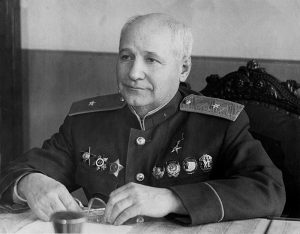
Russia has a long journey in and history of aviation in its book. The inventors from the nation had done a lot to make the airplanes the way they are now, and Russia wants to stay strong in the field and keep using the aircrafts manufactured in the country instead of purchasing foreign products. Among the great names that appear in the Russian aviation history, there is Andrei Nikolaevich Tupolev. We will shortly take a look at his background and contribution.
Short Biography of Tupolev
Andrei Nikolaevich Tupolev was born on November 10, 1888, in the village of Pustomazovo (now does not exist, was between the villages of Abrosimovo and Simonovo in the Kimrsky district, Tver region) into the family of a provincial notary.
In 1908 he entered the Imperial Moscow Technical School where he seriously became interested in aerodynamics. Tupolev also became the member of the Aeronautical Circle since 1909. He participated in the construction of the glider, on which in 1910 he made his first flight on his own.
On October 21, 1937, Tupolev was arrested on charges of sabotage, belonging to a counter-revolutionary organization. Along with him, many leading experts from TsAGI and OKB, directors of most aircraft factories, were arrested. On May 28, 1940, he was sentenced by the VKVS of the USSR to 15 years in prison. He was accused of creating a destructive organization that handed over blueprints of aircraft to foreign intelligence. According to the testimony of the Chief Air Marshal A.E. Golovanov, in a conversation with him I.V. Stalin, Tupolev is not guilty. The incriminating facts considered by the investigation had nothing to do with the content of the sentence. While in custody, he worked in the closed design bureau of the NKVD – TsKB-29. In July 1941, he was released from further serving of sentence with the removal of a criminal record. Tupolev was completely rehabilitated on April 9, 1955.
Tupolev passed away in Moscow on December 23, 1972.
Tupolev and Russian Aviation
In 1916-1918, Tupolev participated in the work of the first aviation settlement bureau in Russia; designed the first wind tunnels in the school. In 1918-1936 he was a member of the board and deputy head of the institute for experimental all-metal aircraft construction. He experimentally proved that the chain-mail aluminum (originally named after the Kolchuginsky plant in the Vladimir region, which was the first to make duralumin in Soviet Russia) is a worthy replacement for aircraft in fragile wood, on the one hand, and heavy iron, on the other.
In 1925, he created the all-metal twin-engine aircraft TB-1, which was distinguished by high flight data and was considered one of the best bombers in the world. In 1932, the improved TB-3 (ANT-6) aircraft was designed, with which in 1937 an expedition was landed at the North Pole. Also in 1932, under the leadership of Tupolev P.O. Sukhoi brigade, the ANT-25 aircraft was constructed. In 1934, the multi-engine ANT-20 aircraft appeared. It had eight engines, a usable area of more than 100 m² and passenger capacity of up to 60 people.
On August 3, 1935, a non-stop attempt of a non-stop transarctic flight crossing Moscow – North Pole – San Francisco on an ANT-25 aircraft with a crew of S. A. Levanevsky (commander), G. F. Baidukov (co-pilot) and V. A. Levchenko (navigator) was carried out. Having overcome part of the way, Levanevsky decided to return due to a technical malfunction (oil began to leak into the cockpit) and sat on the airfield of the Krechevitsy village near Novgorod. It was a big failure for both Russian aviation and Tupolev.
Tupolev’s Great Contributions
Despite the failure, here is the list of things Tupolev has done for the Russian aviation:
1. He developed aviation science and its experimental base; becoming the inspirer and founder of the Russian metal aircraft industry in the era of the dominance of wooden structures, and this created the vector of development of the world aircraft industry, directing it on a promising path.
2. Tupolev and his team in the 1920s created heavy bombers, according to their constructive and layout solutions for many years, determined the development of heavy aircraft, both military and civilian.
3. For the first time, Soviet pilots landed on the Tupolev planes at the North Pole; on his machines, the crews of Chkalov and Gromov made record flights from Moscow to the USA.
4. At his initiative, the first domestic jet passenger aircraft Tu-104 was created, which laid the foundation for the mass operation of passenger jet aircraft in the world.
5. Under his leadership, first-class military and passenger aircraft of various purposes were created, which largely determined the face of world aviation in the 20th century.
6. Thanks to the efforts of Tupolev, large-scale production of metal planes began in the country, and he also developed a technology that accelerated the assembly process of these aircraft. The designer led the production of scouts, fighters, bombers, transport, passenger, marine aircraft, as well as torpedo boats, snowmobiles, gondolas, motor installations and the first Soviet airships. A large contribution to aviation construction was made by the individual propaganda aircraft Pravda, Maxim Gorky, and Rodina created by Tupolev.
7. Thanks to Tupolev, more than 100 types of aircraft were designed, 70 of which were put into mass production. Aircraft designer aircraft are operated by airlines in dozens of countries.
From the list above, there is not much to say what Andrei Nikolaevich Tupolev has done for Russia and its aviation development. The country’s today aircraft industry surely owes him a lot which then turns into a good spirit to continue Tupolev’s hard work to keep Russia forward in the “league” as once Dmitry Medvedev said.
